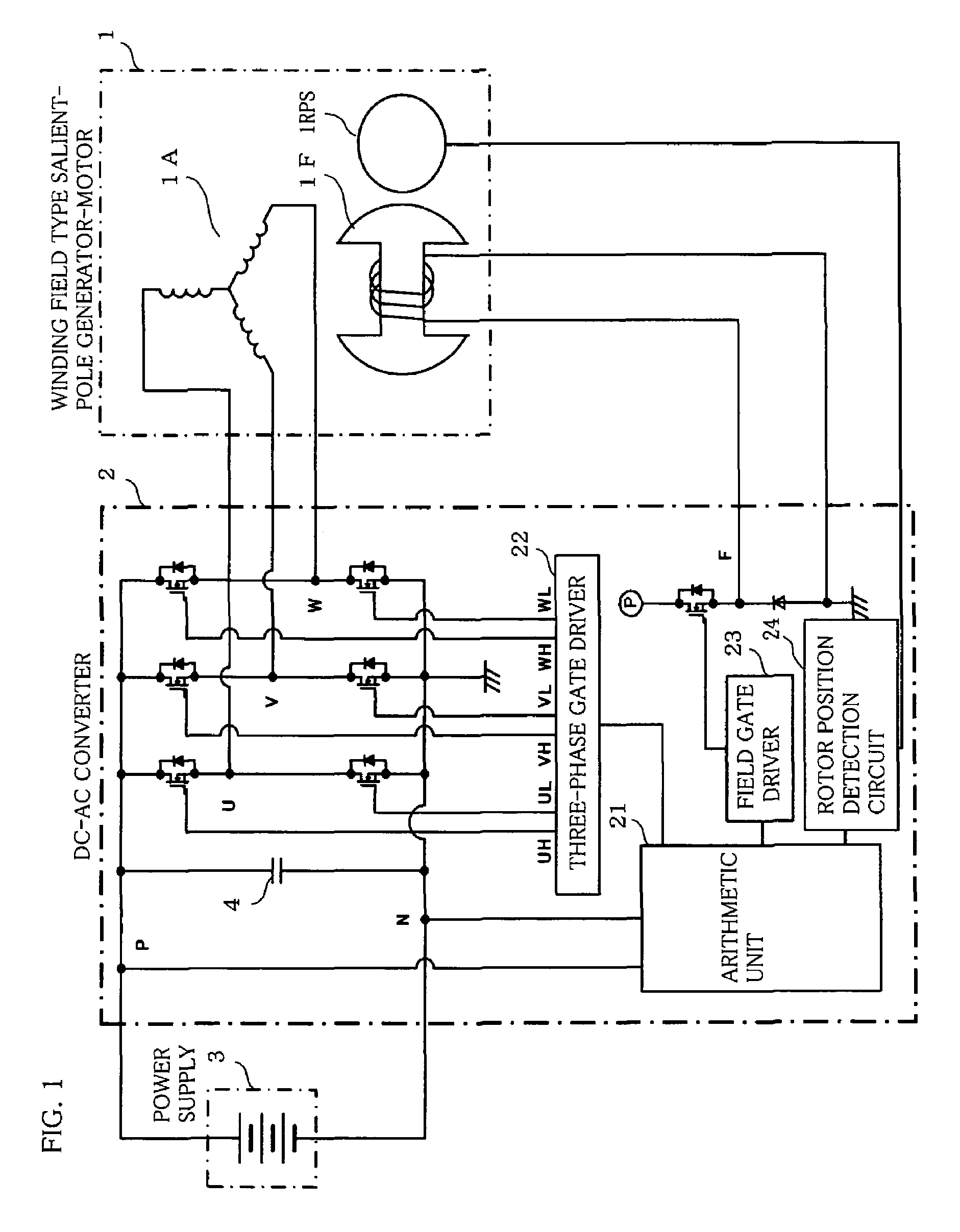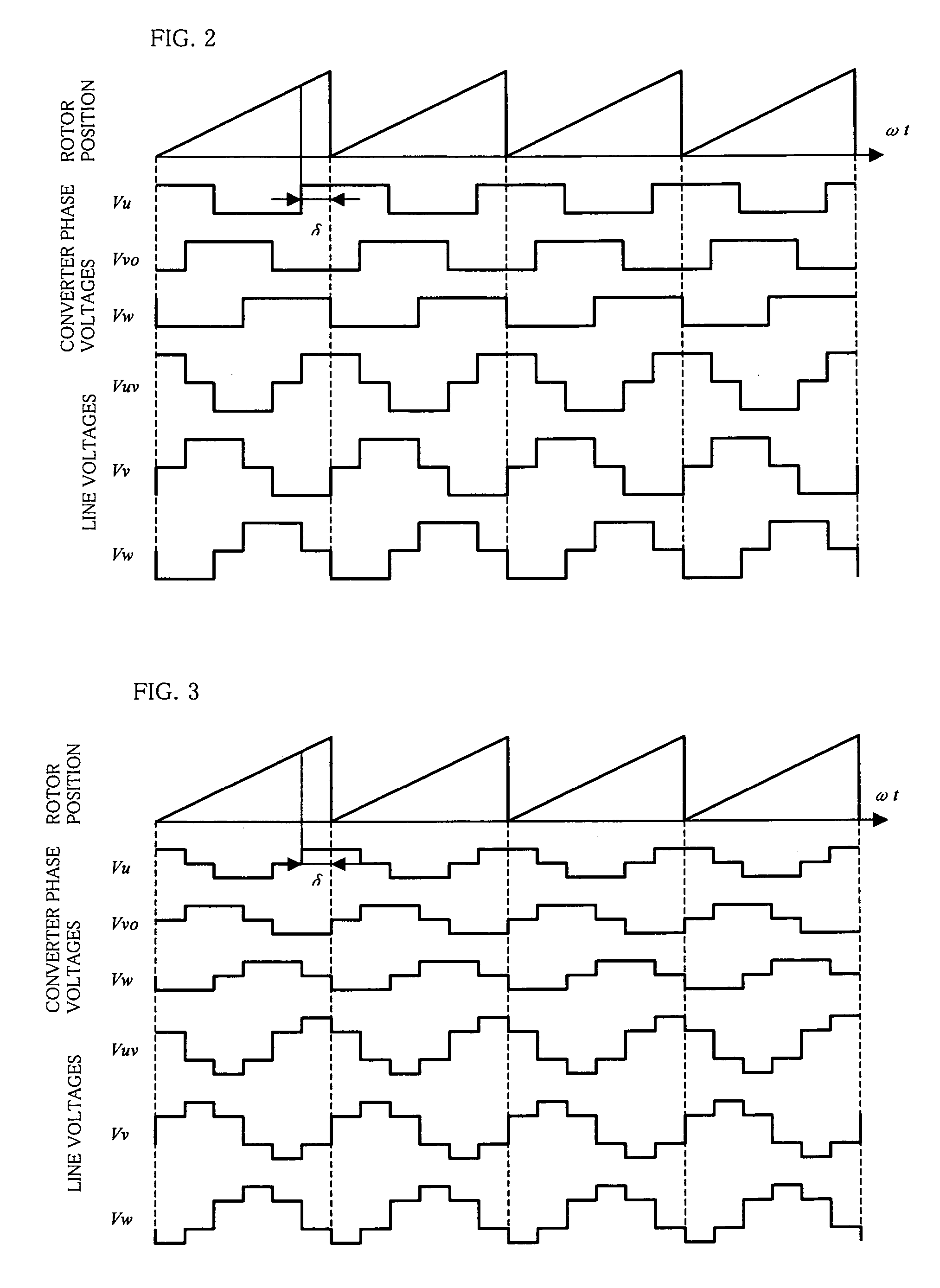Vehicular generator-motor control apparatus
a technology of motor control and generator, which is applied in the direction of electric generator control, electric commutator, engine starter, etc., can solve the problems of discontinuous torque, unfavorable control of motor speed, so as to enhance the torque
- Summary
- Abstract
- Description
- Claims
- Application Information
AI Technical Summary
Benefits of technology
Problems solved by technology
Method used
Image
Examples
embodiment 1
[0029]Now, Embodiment 1 of this invention will be described with reference to FIGS. 1-8. Incidentally, throughout the drawings, identical numerals and signs indicate identical portions.
[0030]FIG. 1 shows a circuit diagram of a winding field type salient-pole generator-motor 1, a DC-AC converter 2 which inputs and outputs currents to and from the generator-motor 1, a DC power supply 3 such as battery, and a smoothing capacitor 4.
[0031]The winding field type salient-pole generator-motor 1 includes a stator (usually, armature) 1A having a winding of Y-connection, a rotor (usually, field magnet) 1F having a winding, and a rotor position sensor 1RPS.
[0032]The DC-AC converter 2 includes an arithmetic unit 21, a three-phase gate driver 22, a field gate driver 23, and a rotor position detection circuit 24.
[0033]The arithmetic unit 21 computes a conduction start angle of each phase of the stator 1A by using a P-N voltage which is the input voltage of the DC-AC converter 2, and that revolutio...
embodiment 2
[0041]Now, Embodiment 2 of this invention will be described with reference to FIG. 9. FIG. 9 shows the set value change of the U-phase conduction start angle dependent upon the temperature of the stator coil of the generator-motor. Thus, the torque can be controlled to the maximum torque or the target torque at each temperature. The temperature of the stator coil may well be substituted by the temperature of the DC-AC converter. Besides, on the occasion of the first engine start at a low temperature, all of the generator-motor, the DC-AC converter and an engine are at substantially equal temperatures, and hence, the conduction start angle may well be set in accordance with the water temperature or oil temperature of the engine.
embodiment 3
[0042]Now, Embodiment 3 of this invention will be described with reference to FIG. 10. In FIG. 10, portions identical or equivalent to those in FIG. 1 are assigned the same numerals and signs as in FIG. 1. FIG. 10 shows a circuit which uses a shunt resistance 6 as field current detection means. The resistance Rt1 of the rotor field winding of a generator-motor changes depending upon temperatures, as indicated by the following formula (Formula 1):
Rt1=(235+t1) / (235+t0)·Rt0 (Formula 1)
where
[0043]t1: actual service temperature,
[0044]t0: reference temperature at which Rt0 has been measured,
[0045]Rt0: resistance at the reference temperature.
Besides, a field current If is determined by the voltage VPN of a power supply, the ON duty (“Duty ”) of a field switching element 5, and the voltage drop of the resistance Rt1 of the field winding, etc., as follows:
If=(VPN·Duty−Vdrop) / Rt0 (Formula 2)
where
[0046]Vdrop: voltage drop of a brush.
[0047]The temperature as in the second embodiment affects t...
PUM
 Login to View More
Login to View More Abstract
Description
Claims
Application Information
 Login to View More
Login to View More - R&D
- Intellectual Property
- Life Sciences
- Materials
- Tech Scout
- Unparalleled Data Quality
- Higher Quality Content
- 60% Fewer Hallucinations
Browse by: Latest US Patents, China's latest patents, Technical Efficacy Thesaurus, Application Domain, Technology Topic, Popular Technical Reports.
© 2025 PatSnap. All rights reserved.Legal|Privacy policy|Modern Slavery Act Transparency Statement|Sitemap|About US| Contact US: help@patsnap.com



